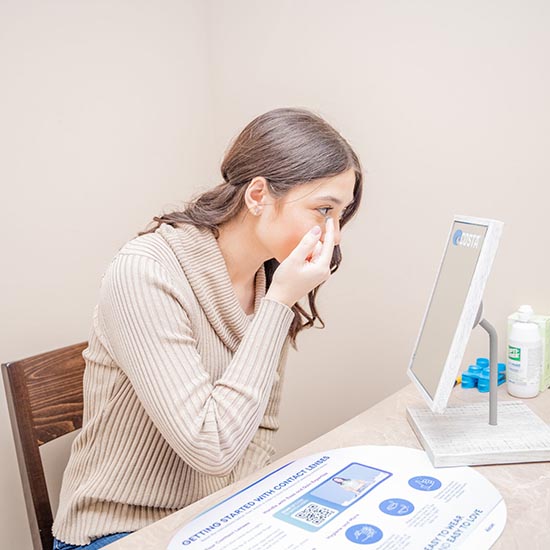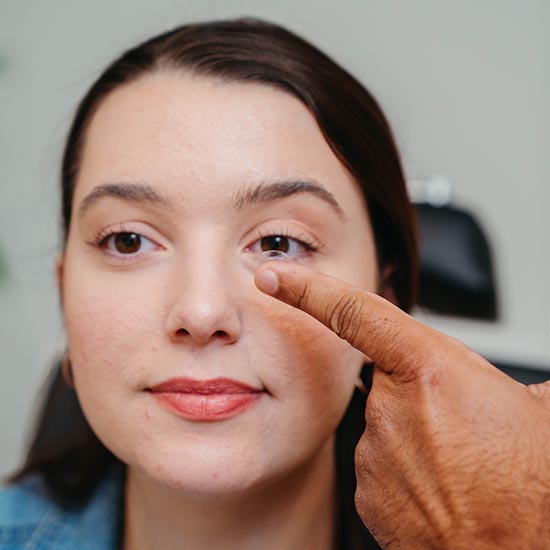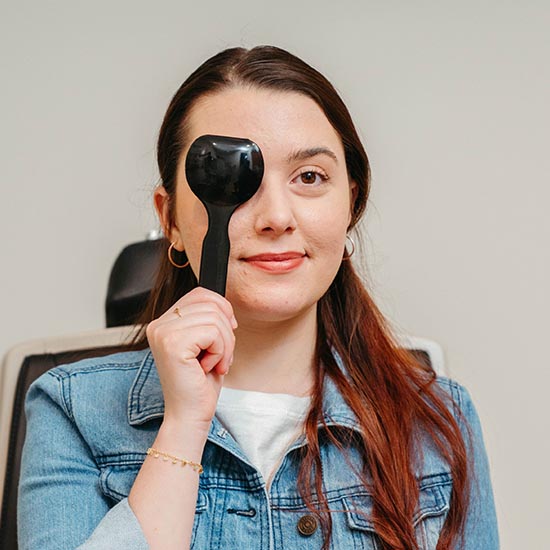Transition Contact Lenses

Transition Contact Lenses at True Eye Experts
See better—with transition contact lenses, you can maintain visual acuity regardless of how bright it may be. Transition contact lenses automatically lighten and darken when exposed to different light levels to ensure you always see your best.
Approved by the FDA in 2018, these lenses are similar to transition eyeglasses that darken with bright sunlight. By adjusting based on brightness, they can make it easier for contact wearers to see better in various settings, like when working on a computer, transitioning from indoor light to outdoor light, and driving. Additionally, they can assist individuals with light sensitivity by dampening the effects of bright lights.

How Do Transition Contact Lenses Work?
Transition contacts have a photochromic additive combined with the typical hydrogel material that contacts are made from. The photochromic additive is what reacts to light. So when the lens is exposed to different light sources, like UV from sunlight or the blue light from your laptop screen, the photochromic additive reacts and darkens.
Lenses take about 45 seconds to darken and about 90 seconds to return to normal. Transition contact lenses will adjust their darkness throughout the day to ensure you are getting the right amount of light reaching your eye.
Who Should Use Transition Contact Lenses?
Transition contact lenses are appropriate for individuals with light sensitivity and photophobia. Basically, if you find yourself squinting to adjust to changes in light, transition lenses may help mitigate uncomfortable light levels.
Keep in mind that while these lenses will automatically darken in bright light, it is still recommended that you use sunglasses to protect your eyes from harmful UV rays if you will be outside for an extended period. Many contact lenses provide some level of protection from UV rays. However, because they don’t cover your entire eye, you should use sunglasses when outside.
Transition contacts are not suitable for individuals who have:
- Severe dry eye
- Diminished corneal sensitivity
- Irritated eyes
- A previously diagnosed condition that makes it uncomfortable to wear contact lenses
- A condition that impacts the eye or which may become more problematic if you wear contacts
- Any eye condition, injury, or abnormality that impacts the cornea, conjunctiva, or eyelids
Schedule an appointment today to better understand whether transition contacts may be right for you.


Transition Contact Lenses: Pros & Cons
Pros
Easily Adjust to a Variety of Light Conditions: Thanks to the photochromic additive in these lenses, they quickly adjust to brighter lighting in about 45 seconds and darker lighting (like when you go back indoors) in about 90 seconds.
Improved color contrast: Studies have shown that individuals who wear transition contact lenses see a more significant distinction between colors.
UVB and UVA Ray Protection: Transition contacts can block up to 100 percent of UVB rays and up to 99 percent of UVA rays to help protect your eyes.
Reduces Light Sensitivity: You can reduce your light sensitivity when wearing transition contact lenses by adjusting to bright lights.
Cons
Color Changing: The darkening effect of these lenses can make your irises appear darker when you are in bright light. Additionally, because they extend beyond your iris, you may have a visible purple-brown ring around your iris when the contacts are darkened.
Ready to Try Transition Contacts?
If you’d like to test out transition contacts to see how they may help you manage your sight, schedule an appointment with True Eye Experts. Our doctors will help you determine whether transition contacts may be right for you. Ready to see better? Schedule an appointment today!
Transition Contacts FAQs
What’s the difference between transition contact lenses and transition lenses?
Both the contacts and eyeglass lenses use the same technology to adjust to light levels. The main difference is how they’re worn and who can wear them. Whereas contact lenses may not be suitable for all individuals, glasses are.
Can transition contact lenses correct astigmatisms?
Astigmatisms can be corrected with contact lenses. However, whether transition contact lenses will help with your particular astigmatism depends on how your astigmatism presents. Ask your doctor whether transition contact lenses will help your astigmatism to get a more definitive answer.
How long do transition contact lenses last?
Right now, the most popular brand is a 2-week disposable. That means that you would wear the contacts for two weeks, then switch to a new pair.
Do transition contacts block blue light?
Yes, transition contacts block a percentage of blue light, up to 15% indoors and about 55% outside.
I get migraines from bright lights. Can these contacts help?
While there is no guarantee that transition contacts will stop migraines, they can help reduce the amount of light that your eye receives so that you are not overstimulated. This reduction in light may help reduce the frequency or severity of your migraines.
Will transition contact lenses make my eyesight worse over time?
Just as regular glasses and contact lenses do not worsen eyesight, transition contact lenses do not worsen eyesight. Vision does change over time, though, so your prescription may change as you get older.
Can I use eye drops with transition contacts?
If you need to use eye drops to combat eye dryness while wearing contacts, invest in an eye drop made for contact lenses. If you consistently have dry eyes, speak to your eye doctor as she may have additional recommendations.
